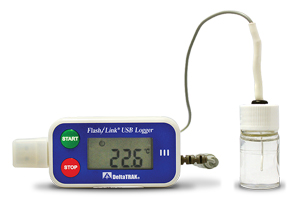What you should know about Lab Refrigerator Alarms
In this post we take a bit of liberty with Murphy’s Law (If something can go wrong it will) and apply it to safe storage of pharmaceuticals, biologicals and other temperature-sensitive products in scientific refrigerators and freezers. Indeed, many of our posts deal with temperature control and temperature monitoring/recording systems for this equipment. Here we focus on the third part of the equation: laboratory refrigerator and freezer temperature alarming systems.
Why Temperature Alarms are Critical
What can go wrong? Perhaps a power failure is first to come to mind. If your facility does not have an emergency generator that immediately comes on line you need a backup plan to quickly move products to an alternate refrigeration system.
Less likely but not unknown is a mechanical failure in the refrigeration system or temperature excursions due to poor maintenance such as ice formation on evaporator coils. Another example is accidently leaving the unit’s door ajar. And as a final example for this post, the temperature monitor that activates the alarm may fail.
Regardless of cause, personnel must be alerted if temperatures go above or below the setting. A quick response to temperature excursions is instrumental in protecting contents from spoilage or loss of potency.
Temperature Alarming Systems
To understand alarming systems we first set the stage.
Temperature alarms are programmed by personnel based on the proper storage temperature of material in freezers and refrigerators. Temperatures are set with mechanical or digital thermostats.
Temperature monitors consist of probes placed in refrigerators and freezers and connected to an on board or external display and control device. Many of these are provided with back-up batteries to maintain function in the event of a power failure.
Detailed information on temperature controls and monitors is found in our post on the subject that focuses on vaccine storage.
On Board Alarming
Examples of on-board systems include Nor-Lake Scientific laboratory freezers and refrigerators available from Tovatech. These are equipped with digital LED microprocessor temperature controllers with hi/lo visual and audible temperature alarms and remote alarm contacts to alert personnel elsewhere in the facility. Temperature sensors are placed in glycerin-filled bottles to better reflect content temperature than the ambient temperature in the unit. Such placement also reduces the chance of activating alarms when the unit door is open.
Power failure alarms and door-ajar alarms are available on selected models of scientific refrigeration systems.
Auxiliary or Optional Alarming Systems
General purpose lab refrigerators and freezers can be fitted with optional digital thermometer alarms consisting of an internal probe in a glycerin-filled bottle attached by wire to an external control and alarming device.
Possibly the best solution to notification of a refrigeration malfunction is the iLab 600 Temperature Monitoring System available from Tovatech. The device operates independently of the unit by collecting data from an internal probe attached through the access port to an external pod that in turn is connected to the facility’s LAN.
The iLab 600 has two functions: a sophisticated programmable high/low temperature alarm that sounds locally and sends email, text, phone or pager alerts to a list of personnel during off hours. It also acquires, remotely stores and instantly retrieves regulatory compliant data reporting on the performance of lab freezers and lab refrigerators.
Optional USB temperature data loggers with built-in alarms are available to automatically record interior temperatures at user-programmable intervals using NIST traceable probes. To read the results, simply plug the USB flash drive into a computer and transfer data to a PC for review and archiving.
Either the iLab 600 or USB data logger is recommended in addition to on-board and optional digital thermometer alarms for two reasons.
First, you should not rely on a single temperature sensor to drive temperature warning systems. There should be at least two completely independent monitoring systems with alarms that tie into independent temperature sensors.
Second, they provide a means of acquiring, storing and retrieving storage temperature data in accordance with good laboratory and good manufacturing processes.
Other Laboratory Refrigeration Tips
Despite sophisticated temperature monitoring and alarming systems it is the responsibility of lab personnel to protect refrigerator and freezer contents from spoilage due to improper storage temperatures.
- Taking a tip from the CDC establish a procedure to visually read and manually document temperatures twice each work day along with the minimum and maximum temperatures each day. If temperature excursions beyond the set storage unit temperature are revealed immediate corrective action can take place.
- Be prepared for an extended power outage. Large facilities should have a backup emergency power system to keep refrigerators and freezers operating. Smaller labs can use portable generators. Absent that they should have procedures in place to quickly transfer valuable specimens, vaccines and pharmaceuticals to an off-site location.
- Remember that full freezers and refrigerators hold their temperature longer. Use ice packs or water bottles to fill empty space.
- Minimize unit access. Every time the door is opened a temperature fluctuation occurs.
- Post operating procedures for twice daily monitoring and recording temperatures, and to guide personnel in responding to power outages.
Contact the scientists at Tovatech for details on protecting contents of laboratory freezers and refrigerators from damage due to temperature excursions.

